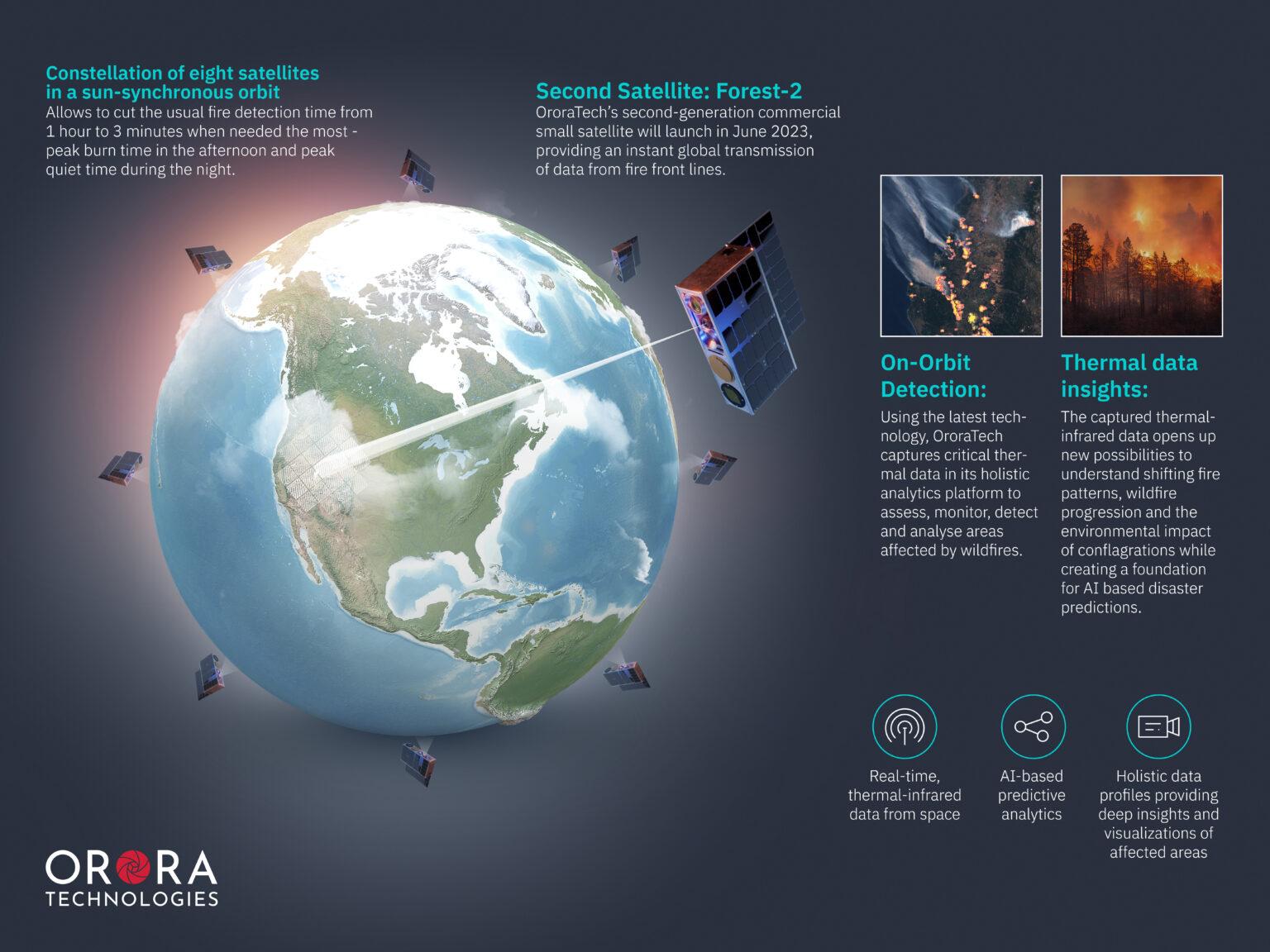Ororatech, a German thermal intelligence startup, has made significant strides in satellite-based thermal imaging, primarily aimed at wildfire detection and environmental monitoring. However, China’s rapid advancements and scale in this sector have positioned it as a dominant player in the global race.
Overview of Ororatech
Founded in 2018 and headquartered in Munich, Germany, Ororatech specializes in developing and operating thermal imaging satellites. The company successfully launched its first satellite-based thermal camera in 2022. Currently, Ororatech plans to deploy 8 satellites by 2025, scaling up to 100 satellites by 2026 to create a high-frequency, global Earth observation network.
Ororatech’s thermal cameras currently complete one full Earth scan per day. Once the full constellation of 100 satellites is operational, this is expected to increase to 48 scans per day, providing unprecedented temporal resolution.
The system can detect heat signatures as small as 13 by 13 feet, enabling wildfire detection with alerts sent to emergency contacts in under three minutes. Beyond wildfire detection, Ororatech is expanding its applications into agriculture (e.g., drought and irrigation monitoring), energy (e.g., thermal leak detection), and insurance (e.g., risk mapping and post-disaster analysis).
The company has secured contracts with prominent clients such as NASA, the Greek government, commercial forestry companies, and public fire departments. In 2025, Ororatech completed a Series B funding round raising $43.5 million, underscoring investor confidence in its growth potential. Ororatech is also integrating artificial intelligence to enhance automated data analysis and actionable insights from thermal imagery.

China’s Rapid Expansion and Leadership
China’s thermal satellite imaging capabilities have grown rapidly, supported by both private companies and state-backed programs. Leading firms like Chang Guang Satellite Technology Co. Ltd. (CGSTL), along with government satellite constellations such as Gaofen and Fengyun, have accelerated satellite deployments and technology development.
- Satellite Fleet Size: China plans to deploy over 150 thermal imaging satellites by 2026, significantly outnumbering Ororatech’s planned 100 satellites.
- Imaging Frequency and Resolution: Chinese satellites offer more frequent revisits (over 60 scans per day) and comparable or better spatial resolution, capable of detecting even smaller heat signatures.
- Investment Scale: Chinese companies often secure funding rounds exceeding $150 million, enabling faster technology upgrades and scale expansion.
- Comprehensive Applications: China’s satellites support a wide range of applications including agriculture, energy grid monitoring, urban heat island analysis, climate change monitoring, and disaster management.
Market Outlook and Industry Landscape
The global satellite imagery market is projected to grow to $14 billion by 2030, with a compound annual growth rate (CAGR) of approximately 19%, according to Euroconsult and NSR. This growth attracts numerous startups specializing in various imaging niches such as military surveillance, climate monitoring, and natural resource management.
Besides Ororatech, several other notable satellite imagery startups are gaining traction:
- Hydrosat: Specializes in thermal imagery for irrigation and crop management, operating 16 satellites that monitor over 1.5 million hectares across 50 countries.
- GalaxEye: Developing multi-sensor satellites combining synthetic aperture radar and multispectral sensors — a first in the industry. Their first satellite launch is planned this year, with costs reportedly less than half of competitors’ satellites.
- AiDash: Provides an AI-powered platform integrating diverse satellite data to deliver insights on weather, fire, and vegetation risks, primarily serving utility providers.
Capability Comparison (2025)
| Feature | Ororatech (Germany) | Leading Chinese Providers (e.g., CGSTL) |
|---|---|---|
| First thermal satellite launch | 2022 | 2020 |
| Planned satellites by 2026 | 100 | 150+ |
| Max revisit frequency per day | 48 scans | 60+ scans |
| Wildfire detection response time | Under 3 minutes | Around 2 minutes |
| Heat detection resolution | 13 ft × 13 ft | Comparable or smaller |
| Series B funding (2025) | $43.5M | Many firms exceed $150M+ |
| Key government clients | NASA, Greece, Fire Services | National forestry and disaster agencies |
Global Earth Observation Market Growth Forecast
| Year | Market Size (USD Billion) | CAGR (Annual Growth) |
|---|---|---|
| 2021 | 4.6 | — |
| 2025 | 8.2 | ~17% |
| 2030 | 14.0 | ~19% |
Source: Euroconsult, NSR, Statista
China vs Ororatech: Company Comparison
| Dimension | Ororatech (Germany) | Leading Chinese Companies (e.g., CGSTL) |
|---|---|---|
| Founded | 2018 | Mostly early 2010s; state projects earlier |
| First Satellite Launch | 2022 | 2020 |
| Planned Satellite Constellation Size (2026) | 100 | 150+ |
| Max Daily Scans | 48 | 60+ |
| Thermal Resolution | 13 ft × 13 ft | Comparable or higher |
| Detection Response Time | < 3 minutes | ~2 minutes |
| Funding Scale | $43.5M Series B (2025) | Multiple firms > $150M |
| Key Clients | NASA, Greece, Public Fire Services | National forestry, disaster agencies, energy & agriculture |
| Application Focus | Wildfire detection, agriculture, energy, insurance | Broad multi-sector applications incl. urban heat, climate |
| Technology Strengths | AI-enabled automated analysis, rapid alerts | Large-scale constellations, multi-sensor fusion, AI data analytics |
| Market Positioning | Focus on Europe & North America, high-end applications | Comprehensive domestic & international coverage, state-backed |
Conclusion: Competitive Landscape and Future Outlook
Ororatech stands out as an innovative and rapidly growing thermal intelligence startup with a strong foothold in Europe and North America. Its focus on rapid wildfire detection, expanding commercial applications, and integration of AI technology position it as a promising competitor in the global market.
Meanwhile, China leverages state-backed initiatives, a large constellation of satellites, and substantial investments in AI-powered data analytics to lead the thermal satellite imaging sector. China’s capabilities in real-time, high-frequency Earth observation set a challenging benchmark for international players.
Looking ahead, Ororatech’s ability to scale its constellation, deepen AI integration, and expand into diverse application sectors will be critical to maintaining competitiveness. The global satellite imagery market’s rapid growth presents vast opportunities, and both Ororatech and Chinese companies are well poised to capitalize on this evolving landscape.